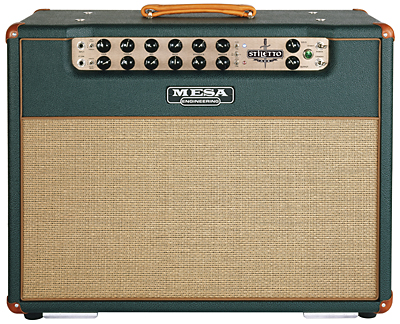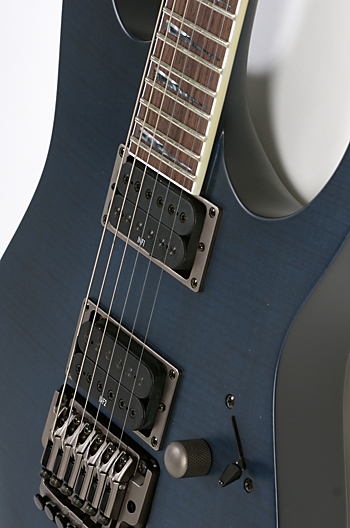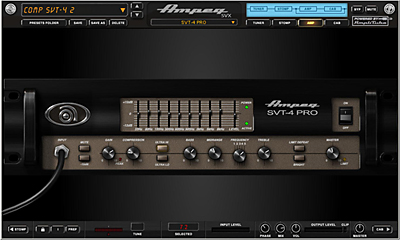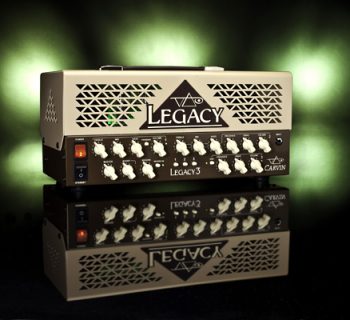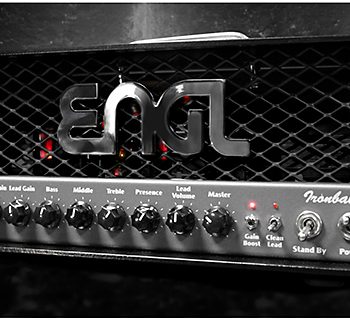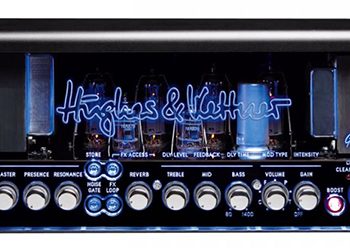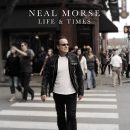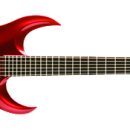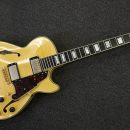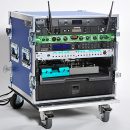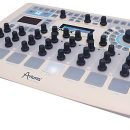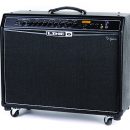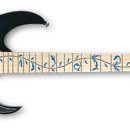The “British Sound” of classic EL-34 based amps has defined much of rock and roll’s sonic history and has inspired the dreams of a multitude of guitarists – those who lust after the focused harmonic lushness and voodoo that only these glowing bottles can conjure. For those who share this dream, prepare to experience it more vividly than ever before.
| Category | Value | Rating |
| Features | 20% | |
| Usability | 25% | |
| Sound | 25% | |
| Documentation & Support | 10% | |
| Price | 20% | |
| OVERALL RATING = 3.5 3.6 stars or better: Outstanding, WIHO Award 3 stars or better: Worth considering 2 stars or better: Suited to specific needs 1 star or less: Not recommended |
||
Not only does the Stiletto Ace walk the hallowed ground of your favorite classic British sounds, it goes far beyond. The amp delves into a ferocious high gain chunk, liquid expressiveness, and, perhaps most surprisingly, also offers one of the finest EL-34 based clean tones around.
Mesa/Boogie’s outstanding build quality and attention to detail also contribute to making the Ace an ideal candidate for the discriminating guitarist of any style who requires a wide range of yesteryear’s iconic sounds, ultra-modern high-gain authority, a pristine clean tone, and the thoughtful set of player-centric features and rugged gig worthiness that you’ve come to expect from Boogie. Our only criticism was that the Ace does not come equipped with Reverb, which kept its scoring just short of reaching our prestigious WIHO award.
Features
- 2xEL-34 power tubes, 5x12AX7 preamp tubes, 1x5U4 rectifier tube
- 50 Watts of Class A/B power
- Fixed bias (no need to re-bias amplifier when replacing power tubes with Mesa/Boogie branded tubes)
- Two fully independent channels, with multiple voicing options for each channel
- Channel assignable, Diode or Tube rectifier tracking
- Bold/Spongy “Variac” switch that adjusts line voltage to help achieve “Brown Sound” tones
- Master output volume control
- Footswitchable Solo control provides user-adjustable gain boost on both channels
- All-tube series effects loop with Send Level control
- True hard bypass switch that removes the effects loop, output level & Solo level controls from signal path
- Slave Out with Level control
- External switching jacks for Channel 1, Channel 2, and Solo
- Two-button footswitch (Channel One/Two and Solo)
- Available as:
- Head
- 1x12 combo,V30 speaker, casters
- 2x12 combo, V30 speaker, casters
- Standard finish: Choice of Emerald Bronco and Tan Grille or Black Taurus and Black Grille, with numerous custom options available
Usability
The Ace’s front panel is clean looking and its controls are laid out in a logical manner that is symmetrical between both channels, with Channel 1’s controls sitting directly above Channel 2’s. Each channel has its own Master, Presence, Bass, Mid, Treble, and Gain control (in that order, from left to right). Additionally, a mini-toggle switch just to the left of the Master control for each channel allows you to choose solid state (Diode) or tube (Tube) rectification independently for each channel. This feature allows you to adjust the feel of each channel’s response by choosing either the percussive quickness of the diode’s response or the looser, more-vintage “sag” of the 5U4G.
Just to the right of the Gain controls for each channel sits another pair of switches that allow you to select each channel’s voicing. Channel 1 is the lower gain of the two channels and offers voicing options of Fat Clean, Tite Clean, and Crunch. Channel 2’s voicing options also include Crunch, but delve further into higher gain territory, offering Tite Gain, and Fluid Drive options. You’ll notice that the Crunch voicing is duplicated between both channels. This is because the authentic classic British sounds that so many players will no doubt want to reproduce were neither truly clean nor inherently high gain. Having the ability to dial in two completely different flavors of these legendary sounds is something that most players will truly appreciate.
Global Output and Solo level controls are also conveniently provided on the front panel. Once the individual channel Masters are set for optimal tone and balance between channels, adjustment of the Ace’s overall volume on stage or in the studio is as simple as reaching for the Output control. The Solo control allows you to set an appropriate level of boost for the footswitch-controlled Solo feature. We’re huge fans of this feature since we don’t have to program level changes in outboard effects nor add a clean boost pedal in order to have some additional volume during soloing.
Rounding out the front panel’s controls are switches for Power and Standby. The Power switch offers the option of selecting the full incoming AC Line Voltage of 117 volts in the On (Bold) position or knocking down the Line Voltage to brown-out like conditions, in a similar fashion to a built-in Variac. The difference between the selected Line Voltages dramatically impacts the way the amp feels as well as the way it sounds. Appropriately named, Bold provides the tightest and most percussive sound and response from the amp, while Spongy makes the sound more elastic feeling and easier to push into overdrive. [We can almost hear light bulbs going off everywhere, as readers now more completely understand where Eddie came up with the term Brown Sound!]
What we didn’t find on the front panel (or anywhere) was a control for Reverb. As we had just gotten accustomed to being spoiled by the Lone Star’s lush tube driven, spring reverb circuitry, we were disappointed to find that the Ace doesn’t come so equipped. Those desiring a little-added ambiance to their sound will either need to add this in the mix, or patch in an external processor.
The rear panel is home to a dedicated Slave Out with Level control for driving external amplifiers, two 4 Ohm and two 8 Ohm speaker jacks for connection of external speaker cabinets, external 1/4" switching jacks for remotely selecting channels or engaging the Solo feature via external connections, and a high quality series effects loop with Send Level control and switchable Hard Bypass control.
It should be noted that when enabling Hard Bypass, the effects loop is completely removed from the amp’s circuitry. Doing so, however, also defeats the global Output and Solo functionality, which is intrinsically linked to this part of the signal path. As the effects loop circuitry is very well designed and quite transparent, we recommend leaving the loop in at all times and bypassing your effects externally (when needed), thus retaining the valuable assets of controlling the Ace’s overall volume via the Output control and switching in the Solo boost function whenever desired.
The Ace comes equipped with two Celestion Vintage 30 speakers that are specially selected by Mesa/Boogie. It should be stated that these speakers are our absolute favorite all-around speaker and quintessential for big high-gain rock tones. Therefore, it goes without saying (although we’re saying it anyway) that we were quite happy to find them here. These incredible drivers are housed in the oversized, Recto inspired closed-back cabinet, which contributes to the Ace’s larger-than-life sound.
The Ace’s complement of five 12AX7 preamp tubes, single 5U4G rectifier tube (channel selectable) and two EL-34 power tubes provide a juicy 50 Watts, offering enough headroom for pristine high volume clean tones, while still ideal for pushing the power tubes into a purring power clip.
Included is a heavy-duty two-button footswitch, which allows for control over channel switching and the Solo feature.
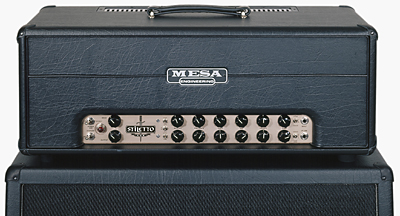
Sound
Knowing that the Ace would appeal to a wide range of guitar players with varied playing styles, we selected an eclectic complement of guitars with which to put it through its paces. These included a PRS Custom 24, a ’59 Gibson ES-335 Dot Re-Issue, a Fender Eric Johnson signature Stratocaster, and an Ibanez RG7620 7-string guitar custom loaded with DiMarzio Blaze and Air Norton 7 pick-ups.
Deciding to begin with the “softer” side of the Ace, we set the amp for maximum clean headroom by switching power to Bold (On), selecting Channel 1, set for Fat Clean, and choosing solid state rectification. Plugging in the Strat, we were immediately rewarded with crisp, silvery tones, which seemed to subliminally demand bluesy fills and chord melody ala Hendrix’s “Little Wing.” The character of this clean tone seemed to be a mix of equal parts Blackface and Plexi. Very impressive!
Dialing in a spanky, percussive clean tone and bringing on da funk was only a matter of switching to the Strat’s notch positions, switching Channel 1’s voicing to Tite Clean, and making a few tone control adjustments. The ample bass response of Fat Clean was now trimmed back to a much leaner low end that allowed faster-strumming patterns and single note work on the lower strings to remain snappy, distinct, and well focused. The overall sound now was tight, crisp, and punchy, with the frequency response now being dominated by the upper midrange.
Swapping over to the ES-335, switching to tube rectification, back to Fat Clean, and adjusting the controls, we were able to cop some very hip Scofield-sounding tones that might surprise the multitudes who would only expect to find such sounds coming from the venerable Vox AC30. Remarkable! Regardless of configuration, it became quickly evident that the Ace’s pristine clean tones easily outshine any other EL-34 based amplifier we have yet to hear.
Having the strong urge to experience first-hand some of the Ace’s much-touted classic tones from across the pond, we decided to dial in a bit of overdrive and turn up loud enough to get the power tubes to sweat. Dropping the Line Voltage via the Spongy selection on the Power switch and changing the channel voicing to Crunch, we hopped into our Way Back Machine and got off in London circa 1966. The combination of preamp break-up and power tube saturation was woody, organic, and addictive.
Bluesy emotive phrasing through the 335 brought to mind Slowhands’ work with the Bluesbreakers. Turning up the gain and switching back to the Strat, we strode off towards that Red House over yonder… Goosing the front-end with a boutique vintage fuzz face clone and we quickly dialed in a tone so good, we just about refused to put our guitar down for “ninety-nine and one-half days!”
There exist a great many shades of legendary British amplifier tone from the classic era of rock, and after spending more time with the Ace, we found that its Crunch voicing reproduces many of them with surprising legitimacy. We suspect that many players, both modern-minded and wistful of days past, will willingly lose themselves in this voicing alone.
Switching to Channel 2’s Tite Gain voicing, selecting the silicon diodes for rectification, and choosing the Bold power option, we decided to transition from vintage to ultra-modern. Plugging in the 7-string Ibanez we were able to unleash a sick aggression that is in a class shared only with Mesa’s mighty Dual and Triple Rectifier designs and few others.
Although equal in aggression, the Ace’s high gain assault is sonically an ocean apart from its Recto cousins. The Stiletto’s EL-34 heritage is undeniable, and the trademark lush harmonic haziness in its searing top end, surgically focused mid-range, and tight, chest-thumping lows are all showcased in vivid three dimensions. The percussive focus of this mode is ideal for 7-string and detuned staccato riffing. Nu Metal, Emo-Core, and Heavy Progressive guitarists will find this sound immediately irreplaceable, especially those sharing the stage with a second guitarist armed with one of Mesa’s Dual or Triple Rectifiers. The Stiletto’s high gain sounds compliment, rather than compete with, the Recto’s, allowing each amp’s sonic character to enhance the other’s.
Swapping guitars one last time – this time the PRS replacing the Ibanez – we ventured forth into the Ace’s final voicing, Fluid Drive. This mode is the darkest and highest gain of all the options, and it is aptly named. Both the sound and the feel of Fluid Drive is very liquid. Those players looking to shred will find this mode’s elastic compression, over-abundance of gain, and lush harmonic spectrum an ideal vehicle for expressing those many hours spent woodshedding their chops.
Not reserved for virtuoso chops alone, Fluid Drive makes emotive, sustaining, single note lines sing with an addictive vocal quality. Setting the power section to Bold and the rectifier to Diode brought forth a lightning fast response that kept quick alternate-picked single-note lines articulate, and double-stops and power chords tight and urgent.
Switching to Spongy yielded a browner sound that will instantly put a smile on the face of anyone who is a fan of the ultra-modded (ala Jose Arredondo and others) Marshall sound that once populated LA’s club scene the way that mouse ears populate Disneyland.
With either setting, this voicing option wonderfully complimented the PRS and brought forth a thick, singing tone that filled out beautifully as we turned up and allowed the power section’s gentle overdrive to compliment the intense preamp gain. The sound became more rounded and vocal, and the halo of harmonic spread crowning the higher frequencies allowed the notes to easily sustain into controllable feedback an octave above the fundamental.
As volume was increased, the much-heralded overdrive characteristics of the EL-34s became more prominent, allowing us to turn down the preamp gain level and more fully enjoy the elusive power-clip magic that these glowing little bottles offer up so willingly. Further dropping the gain level and replacing the PRS with the ES-335 changed the timbre from a waterfall of sonic mercury to a woody, vocal, throatiness that changed the mood from red hot to cool blue. Rolling back the guitar’s volume controls showcased the Ace’s dynamic responsiveness to input level and allowed us to go from a gutsy, bluesy growl, to an over the top wail with just a twist of the knob. Truly addictive!
Overall, the Ace brought forth the sonic goods to satisfy the needs and desires of a diverse array of guitar players, doing so with inscrutable legitimacy to its sonic heritage and unabashed attitude with regards to its own groundbreaking sounds. For many aficionados of the EL-34 sound, the Ace will prove to be a must-have piece!
Documentation and Product Support
Those already familiar with Mesa/Boogie products will no doubt be familiar with the excellent documentation that accompanies their amplifiers, and the unique style in which it is written. Those unfamiliar with Mesa/Boogie’s superb documentation or their legendary customer service and product support are encouraged to read through the Documentation and Product Support section of our recent Lone Star review, where we go into greater detail regarding these important areas where Mesa/Boogie deserves a lavish amount of praise.
The Ace combo arrived with a well written, insightful, and extremely detailed user’s manual, some very informative technical writings by Randall Smith on tube technology (including biasing), a full-color catalog, and current price list. In addition to explaining the comprehensive feature set of this amplifier in great detail and offering valuable insight into coaxing the best sounds from each of its voicing options, the user manual offers a number of instant gratification settings for those that want to “play now and read later.”
As alluded to above, and talked about in great detail in our Lone Star review, product support and customer service at Mesa/Boogie is second to none!
Price
$1,499.00 Head
$1,599.00 1x12 Combo
$1,699.00 2x12 Combo
Numerous custom options are available at an additional cost (typically in the $150-$500 range) for different colors, grill coverings, and cabinet materials. Options range from colored vinyl to leather, suede, and hardwood.
Our review unit featured a classy standard dress of Emerald Bronco, tan grille covering, and tan leather appointments. All Mesa/Boogie amps come with slipcovers. Details on custom options can be found on the Mesa/Boogie web site.
Other Comments
While Mesa/Boogie has utilized the EL-34 to some degree since its early Mark series designs (many current designs even offer the ability to swap the full complement of power tubes for EL-34s), the Stiletto amplifiers mark the first-ever designs by Randall Smith and company entirely based around the EL-34.
This is a significant milestone for Mesa/Boogie as designing and optimizing the circuitry specifically around current production EL-34s has culminated in an amplifier design that is reliable, extremely versatile, and able to produce an amazing array of incredible tones spanning the historical sounds of classic rock through the ultra-modern sounds of today.
Contact Information
Mesa/Boogie
www.mesaboogie.com
| Evaluation Short-List |
|

